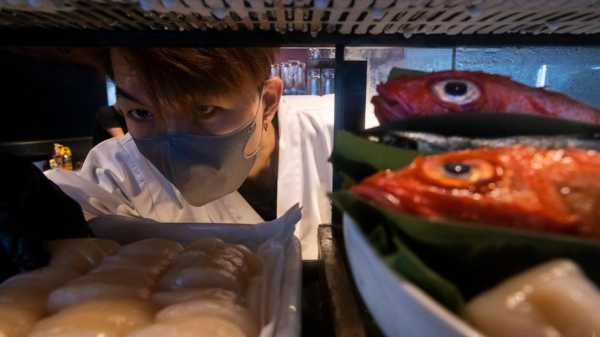
HONG KONG — As Tokyo plans to discharge treated radioactive wastewater into the sea, Japanese restaurant operator Sam Lam is busy finding substitutes for Japanese seafood that could soon be banned from entering Hong Kong.
The Hong Kong government said last Wednesday that the city would immediately bar the import of aquatic products from 10 Japanese prefectures if wastewater from the damaged Fukushima nuclear plant is released into the Pacific Ocean.
Lam said his team could get seafood from other sources and change menus to adjust to the ban, but he predicted that revenues could nevertheless drop from 10% to 20% if the Japanese and Hong Kong governments press ahead with their plans.
“My customers told me that once the water is discharged, they will eat fewer (aquatic products) or stop eating them,” he said in an interview Friday.
Lam is not alone among Japanese restaurants and seafood suppliers in Hong Kong who are bracing for a slump in business under the potential ban, and who fear that the discharge could lead to a general decline of confidence in the safety of seafood.
The financial hub was Japan's second biggest market for fishery exports after mainland China and purchased 75.5 billion yen ($546 million) worth of aquatic products from the country last year, the Japanese government's data showed.
The 10 affected prefectures — Tokyo, Fukushima, Chiba, Tochigi, Ibaraki, Gunma, Miyagi, Niigata, Nagano and Saitama — provide about 15% of the total amount of imported aquatic products from Japan, according to estimates by Simon Wong, president of the Hong Kong Federation of Restaurants and Related Trade.
Wong said the city's Japanese restaurants could find substitute seafood products from other regions, but they may not share the same level of prestige, and that could mar a restaurant's image or make customers feel that the food is less authentic.
“After moving past the pandemic, businesses were hoping that crisis is a thing of the past already. They don't know if this incident will bring another crisis," he said.
He said the industry took about a year to restore the public's confidence in Japanese food after the Fukushima nuclear crisis in March 2011. He said if the current safety concerns aren't immediately resolved, the industry might need more than nine months to restore some level of confidence.
A massive earthquake and tsunami in 2011 destroyed the Fukushima Daiichi nuclear plant’s cooling systems, causing three reactors to melt and releasing large amounts of radiation. The tanks where water used to cool the reactor cores is stored will reach their capacity in early 2024.
In 2021, Japan’s government announced plans to gradually release the treated — but still slightly radioactive — water after being diluted to what it says are safe levels. The U.N. nuclear agency endorsed the plans, saying they meet international standards. But the idea is opposed by groups in South Korea, China and some Pacific Island nations because of safety concerns and political reasons. Local fishing organizations fear that their reputation will be damaged even if their catch isn’t contaminated.
Christine Huang, who imports Japanese food from outside the 10 prefectures targeted in the potential ban, remembered the pain in 2011.
Consumer worries triggered by the Fukushima accident led to her company's revenues being halved for a period of two to three months, said Huang, the director at Best Quality Food. Workers at her company were forced to take unpaid leave, she added.
She worried that the release at Fukushima could again shake Hong Kongers’ confidence in the safety of Japanese food in the short term. “If business at Japanese restaurants turn bad, we will be quite miserable,” she said.
Murakami Satoshi, a wholesaler who imported seafood such as saury from the affected prefecture of Miyagi, also predicted a potential drop in sales due to the ban. To allay concerns of his restaurant clients, he said he would boost efforts to get seafood from unaffected regions, such as the Japanese islands of Kyushu and Hokkaido.
Those who sell seafood products from outside Japan also voiced concerns. Local seafood wholesale company worker Fung See foresaw his company's revenues could drop at least 20% to 30% due to consumers’ worries even though they mainly trade fish from Hong Kong and mainland China.
Oyster shop owner Wilson Lau, who sells shellfish from Miyagi, said he was not bothered. “Fresh oysters also exist in many countries," said Lau, who is director of the HK Oyster Concern Group. “Even if consumers do not eat Japanese oysters, they can eat other types of oysters.”
At about Friday's noon at Sam Lam's Japanese restaurant, fewer customers were ordering sashimi than usual. Of about 10 meal sets Lam checked, only one was sashimi, he said.
Customer Yo Kong said she's been dining more at Japanese restaurants lately to get her fill ahead of the expected discharge at Fukushima. Once that happens, the 50-year-old insurance manager said she might stop eating sashimi for a few months.
“I will just have more when it's still OK to eat,” she said.
___
Associated Press news assistant Annie Cheung contributed to this report.
Sourse: abcnews.go.com






